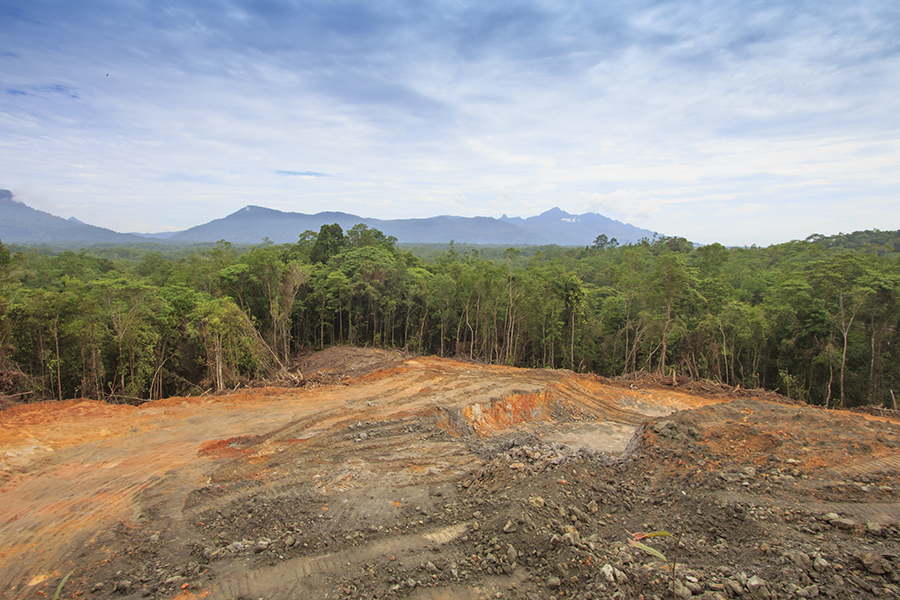From The Intelligent Optimist Magazine
Summer 2016
On a mission to save orangutans, Willie Smits rebuilt a devastated rainforest where no rain fell, no birds sang, and the people spent a quarter of their resources just to get enough water to survive.
By Rosamund Stone Zander
Rosamund Zander, co-author, with Benjamin Zander, of the bestselling The Art of Possibility, has written a new book, Pathways to Possibility, in which she deepens the practices of their earlier work. The new book offers readers a blueprint for upgrading the narratives that hold their lives captive and presents stories of people who were able to transform themselves and then easily wrest possibility out of circumstances where others saw none. This is an edited excerpt from Pathways that tells the unlikely story of a man who witnessed the disenfranchisement of the orangutans in Borneo due to destruction of their habitat by industry, and who single-handedly reinvigorated an entire rainforest, restoring the animals’ domain and providing sustenance for the people.
As Rosamund Zander links your own transformation to your accomplishment in the world, we have included a second excerpt describing one of the games she offers to help you grow in power and effectiveness.
Perhaps the most important thing to be learned from the following story is that if we shift our attention away from what we think we want, and put it on what our hearts tell us life wants, we will find ourselves becoming extremely powerful in creating the conditions and connections that were missing for us and all others.
The following is the story of a man who boldly took on nature’s processes on her own turf, in her own shoes, offering himself and his technology to her with the utmost intelligence and respect. By so doing he was led to witness, under his own hands, life at its most miraculous, and so will we.
The story goes that while working as a forest researcher in East Kalimantan, Indonesia, in 1989, where half of the primary forest had been destroyed through clear-cutting, Dr. Willie Smits and his wife were walking around an outdoor market and met the gaze of a baby orangutan peering out of a cage. The baby orangutan, said Smits, had the saddest eyes he had ever seen. Later, in the night, he returned to look for the caged baby and found its body thrown on a rubbish heap, still barely alive, the cage gone. He took the infant orangutan home, rubbed its belly, made it drink and nursed it back to health. Word got around, and people began bringing other displaced, hurt or abandoned orangutans to his care. The work that he started there of rescuing, rehabilitating and releasing orangutans into the wild developed into what became the Borneo Orangutan Survival Foundation.
To save the orangutans, Smits realized that the priority had to be restoring their forest habitats, and to do that, he had to return economic security to the local people, whose only means of livelihood had been reduced to what they gained from cutting down trees. With the backing of the Borneo Orangutan Survival Foundation, in 2001 he leaped into one of the most ambitious reforestation projects ever conceived, rebuilding a completely devastated rainforest of 2,000 hectares (7.7 square miles) where at the start no rain fell, no species lived, no birds sang, no industry took hold and the local people spent 22 percent of their meager resources just to get enough water to survive.
Willie took on his project with a vengeance. “My idea was,” he says, “if I can do this in the worst possible place I can think of, where there is really nothing left, no one will have an excuse to say, ‘Yeah, but …’”
His intent was to create a set of recipes to restore what man has destroyed, and in Samboja Lestari, an area of Borneo adjacent to the small village of Samboja, the first steps were to acquire the land from the locals. The plan was to pay some families outright for their property, or to give them land within the restoration area to grow food for their families in exchange for their help in rebuilding and protecting the forest. “What I really did,” Smits says, “I just followed nature.” First they planted low-yield acacia trees, along with many other types of trees, for diversity that in a few years’ time would produce timber, then they ringed the 5,000 acres with a thick thorny hedge to provide protection for the orangutans, for whom they made a sanctuary in the center. Next they planted biofuel-rich sugar palms all along the edge—a completely different tree from the oil palm whose monoculture had destroyed the area. The sugar palms would be able, within six years, to provide plenty of income to support and sustain the local people.
The recipe for the middle area was first to plant pineapples, beans and corn; in the second phase, bananas and papayas; and, later, chocolate and chiles, so that the people would always have some food and some income. Then, slowly, the trees that were planted first would take over and bring in fruits and timber and fuel wood. Finally, the sugar palm forest would flourish and provide people with permanent income. Sugar palms thrive only in a diverse forest, so they had no chance when Smits and his native team began. But once the other trees took root, the sugar palms grew to stand as protective sentinels for the whole project: they are fire and flood resistant, need no fertilizer, are champion photosynthesizers and, because of their deep roots, enrich the soil around them. Each tree is tapped two or three times a day for its abundant juice, which can be made into sugar products and ethanol for fuel and electricity.
“A natural forest has many layers on the ground and above, so I followed nature’s plan as closely as I could,” says Smits. “We grow fast-growing trees and then slow growing of high diversity, and the right fungi that brings nourishment back to the trees.” The fungi turned out to be a far more critical part of the ecosystem than Smits at first understood.
Education of the people is a crucial step in this recipe for transformation. Smits introduced the villagers to the many aspects of the life cycle of a forest, and to new technologies to monitor growth, and as they learned, they developed a proprietary feeling for every aspect of the project. They planted thousands of trees, Smits says, representing ten times the variety of species in all of Europe.
At the three-year mark, rain was again able to form above Samboja Lestari, because in this type of ecosystem it is the leaves of trees that call forth the rain. The clear-cutting had produced an ecosystem that was dry, overheated and inhospitable to life of any kind. But in a mere 36 months of careful and cooperative reforesting, temperatures had dropped approximately eight to ten degrees Fahrenheit, and the preserve, which had been almost devoid of life, was home once again to 137 species of birds and 30 species of reptiles.
At four years, the climate in Samboja Lestari had changed in every way. (Who says it can’t be done?) Fires and floods were no longer threats, the temperature and humidity had become life-supporting, biodiversity was vastly increased and, where once the land was burned and scarred, now all you could see from the air was green. At this point Willie Smits gave the people back the land he had bought from them. In addition, at this four-year mark, Samboja Lestari was supporting 3,000 jobs. The people deeply understand, says Smits, that their lives depend on the forest, and each village had designed its own unique way of assuring that everyone cooperates, so that no one in their midst cuts down prohibited trees or violates in any way the plan for the forest.
A few years later, Smits invented a compact, portable palm sugar processor that can be dropped into the most remote village by helicopter. The little factory is, like nature, a no-waste operation making sugar and ethanol, with by-products of algae, for animal food and fertilizer, and, by way of a filtering process, clean air and clean water. Now the cycle is complete: the forest and the people take care of each other in a richly sustainable way, the children are being educated, and the orangutans, the impetus for the entire project, enjoy a protected life in the center of it all.
This is an edited excerpt from Pathways to Possibility: Transforming Our Relationship with Ourselves, Each Other, and the World, by Rosamund Stone Zander (Viking, June 2016).

Willie Smits with some of the apes that he saved from nightclubs and tourist attractions.

Deforestation: Scarred earth where tropical rain forest has been destroyed by human development in Borneo, Malaysia.
___________________________________
Miracles appear like fireflies
The “you” of the stationary world—right-minded, coercive and domineering—takes on cartoon form, and you keep popping up as your own favorite joke.
There is a game that I’m particularly fond of. It’s playeD like this: You pick one of the following qualities—wonder, desire, service, authenticity, vitality, lightness and courage—and commit to making every decision in line with that choice over one to three days.
Granting myself a gift for precognition, I’m going to describe what will happen for you when you opt to play this game and choose the quality “lightness.”
The first ten things that go wrong in your day you will later see are part of basic training. You get nervous when you realize you’ve run out of coffee, convinced you will not be up to the challenges ahead. In the spirit of the game, you declare, with false cheer, “Oh, I’ll do fine.” And then you’re amused to notice that you feel, well, fine. The newspaper informs you that the terror alert level is up to orange. After the stomach tightening and the habitual internal argument—“What are we supposed to do about it, for heaven’s sake?”—you say lightly, “Thanks for sharing,” and pat the newspaper fondly. You are amused at how good you feel.
But by noon you are in a foul mood. You’re still unable to rouse your son, just back from his graduation from college. You see the summer stretching out drearily ahead, day turning into night, no job, no productivity, his chances of success slipping away. As you hold on to the newel post and shout up the stairs, you glimpse the word you have written on a piece of masking tape stuck to your arm: LIGHTNESS. “How the !@#$% do I deal with this lightly?!” Simply remembering the word “commit” gets you back on course.
You begin to lighten up when you have a brief moment of clarity: Your son is blissfully sleeping the day away in his childhood room (free of charge, of course), and you, though shouting noisily, are keeping forever silent on the subject of what you want from him. So he might as well be 13 years old, and you might as well be the parent of a young teen, the way you are acting, asking nothing of him and bellowing up the stairs. The humor in it doesn’t escape you. You suddenly don’t care whether he appears at all today, making a mental note to work it out with him sometime when you are both awake. You call a friend and suggest meeting for a light lunch.
When you extend the game beyond basic training, miracles appear like fireflies. Tasks that you traditionally viewed as onerous you carry out easily, and with a light step, because you can. It’s the simplest thing in the world. People around you seem to “hear” you better, so you don’t have to shout and become emphatic. You develop a light step, a light touch, light in the eyes, and you begin to take yourself lightly. Even the cloudy weather is enlivening to you, because it is … so completely itself.
You give up all efforts at control—you walk by your daughter’s clothes, spread from one end of the house to the other, and let them be. In another moment, you put on some inspiring music and wash every dish in the sink.
The “you” of the stationary world—right-minded, coercive and domineering—takes on cartoon form, and you keep popping up as your own favorite joke. From this ebullient place, a desire is hardly out of your mouth before the world starts to shift and change to accommodate it. “Let’s revitalize the ocean!” you declare cheerfully. Your son, that son who was never going to get out of bed, appears in the doorway, still sleepy, and tells you he has an interview tomorrow for an internship at the state senator’s office of environmental affairs.












